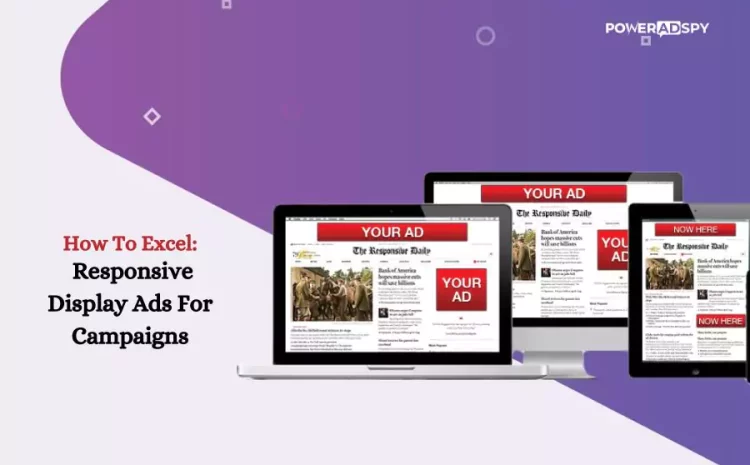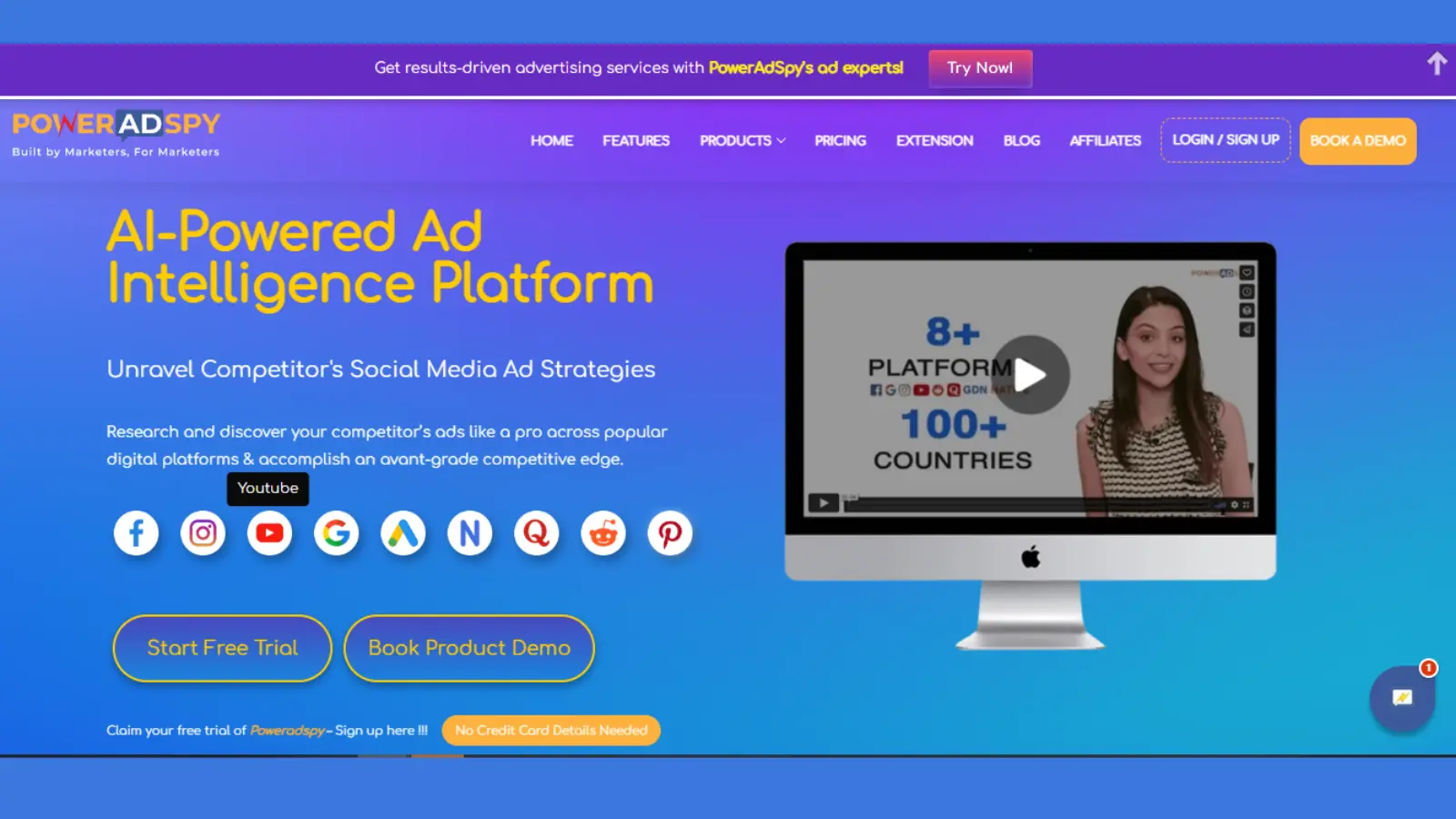How To Excel: Responsive Display Ads For Campaigns
Looking to boost your online presence? Responsive display ads could be your game-changer! In today’s online arena, effective advertising is key, and these ads offer a powerful way to reach your audience across devices.
Wondering how to make these ads work for you? You’re in the right place! In this blog, we’ll break down the magic behind these Display Ads and show you step-by-step how to use them to elevate your campaigns.
Get ready to unlock the secrets to creating eye-catching ads that connect and convert!
Listen To The Blog Now!!
What Are Responsive Display Ads?
Responsive Display Ads are versatile advertisements designed to adapt to various ad spaces across the web. Unlike traditional static ads, these dynamic creatives automatically adjust their size, appearance, and format to fit the layout and dimensions of the device or website where they’re displayed.
They typically comprise multiple images, headlines, descriptions, and logos, allowing the ad system to mix and match these elements to create personalized ads for different viewers.
These Display Ads optimize themselves based on performance data and user interactions, aiming to deliver the most engaging content to each viewer. This adaptability enables advertisers to reach a broader audience across diverse platforms, from mobile devices to websites, maximizing visibility and engagement.
Google responsive display ads are designed to adapt to various sizes and formats across the Google Display Network, allowing advertisers to reach potential customers on websites, apps, and other placements. Here are a few responsive Google display ad examples:
Image-Based Responsive Display Ad:
- This type of ad typically includes an image or multiple images with accompanying text.
- Images can showcase products, services, or branding elements.
- Text can include a headline, description, and a call-to-action.
- Example headline: “Discover Our Latest Collection”
- Example description: “Shop now for exclusive deals!”
- Example call-to-action: “Shop Now”
Carousel Responsive Display Ad:
- This format allows advertisers to showcase multiple images or products within a single ad unit.
- Users can swipe or click through the carousel to view different offerings.
- Each carousel card can have its headline, description, and call-to-action.
- Example headline: “Explore Our Best Sellers”
- Example description: “Find what you love!”
- Example call-to-action: “Learn More”
Video-Based Responsive Display Ad:
- These ads feature video content, which can capture attention more effectively than static images.
- Videos can demonstrate products, services, or tell a brand story.
- Accompanying text can provide additional context or encourage action.
- Example headline: “See Our Product in Action”
- Example description: “Discover the benefits!”
- Example call-to-action: “Watch Now”
Animated Responsive Display Ad:
- Animated ads use motion or transitions to engage users.
- They can be created using HTML5 or animated GIFs.
- Animation can highlight key features, promotions, or branding elements.
- Example headline: “Don’t Miss Out on Savings”
- Example description: “Limited time offer!”
- Example call-to-action: “Shop Now”
These display ad examples showcase the flexibility and variety of responsive Google display ads, allowing advertisers to create engaging and effective campaigns that adapt to different placements and devices.
Do you often wonder, what’s a key benefit of responsive display ads? Don’t worry anymore. We have got the solution for you.
Benefits Of Responsive Display Ads
Responsive display ads excel in driving improved ad performance and effectiveness. Let’s explore some of key benefits of responsive display ads:
Expanding Your Reach:
Google’s advanced technology uses machine learning to create ads that adapt to different places online. This means your ads can show up in lots of places you might not have thought of before, like text ads, banner ads, or video ads, all in one campaign!
Saves You Time:
Instead of making lots of different ads for different sizes, Google makes one ad that changes based on what you want to test. For example, if you want to try five different headlines, you only need to make one ad instead of five. This saves you a ton of time, especially if you’re using different ad sizes.
Better Click-Through Rates:
Unlike regular display ads that people might ignore, responsive ads use smart technology to test different versions and find the ones that work best. You don’t have to spend time analyzing which version is doing better because Google does it for you automatically.
More Leads:
When your ads get more clicks, you’ll likely get more people signing up or buying from you. Google can track how many people take action after seeing your ads, so you can focus on the ones that bring in the most leads without spending extra money.
Great For Mobile Users:
Responsive ads are designed to look good on all screen sizes, which is perfect if you have a mobile website or app. Google figures out the best layout for your ad, helping you reach more people on their phones or tablets.
Easy Performance Monitoring:
Google keeps track of how each part of your ad is doing, like headlines, descriptions, and images. This way, you can see what’s working well and make changes to improve your results.
Works With Remarketing:
Remarketing is a powerful way to advertise to people who have visited your site before. Responsive ads can be used for dynamic remarketing, where Google display ads shows personalized ads to people based on what they looked at on your site. This can boost your chances of getting them to come back and buy something.
Responsive Display Ads emerge as a tool for advertisers, providing an efficient, engaging, and adaptable platform to connect with a diverse audience across multiple platforms, thereby amplifying campaign effectiveness and audience engagement.
Best Practices For Utilizing Responsive Display Ads
Optimizing the impact of Google’s responsive display ads demands adherence to industry best practices. Incorporating these proven strategies ensures your ads captivate audiences, boost engagement, and yield exceptional outcomes.
Let’s explore Display ads best practices for crafting compelling visuals and copy, testing and refining ad elements, and leveraging performance data to steer your ads toward unparalleled success.
Creating Compelling Visuals And Copy: Engaging visuals and effective ad copy are crucial for grabbing attention. Invest in high-quality visuals that align with your brand and work well on diverse screens. Experiment with colors, imagery, and fonts to create a cohesive experience. Craft concise, impactful copy that communicates clearly and motivates action. The coordination between captivating visuals and persuasive text significantly enhances ad effectiveness.
Testing And Optimizing Ad Elements: A/B testing various ad elements is essential. Experiment with headlines, descriptions, visuals, and calls to action to discern the most engaging combinations. Analyze metrics like click-through rates and conversions to refine your approach continuously.
Monitoring And Adjusting Performance: Regularly track metrics such as impressions, clicks, conversions, and cost-per-conversion. Use Google Ad Spy tools like PowerAdSpy for detailed insights. Identify trends and areas for improvement, making data-driven adjustments to boost ad efficiency.
Integrating these principles, along with tools like PowerAdSpy, maximizes the potential of your responsive display ads. Continual refinement remains crucial in staying ahead. Embrace these practices to ensure your ads inspire action and achieve objectives efficiently.
PowerAdSpy- AI-Powered Ad Intelligence Platform
PowerAdSpy is a powerful tool designed to uncover insights and strategies from Google display ads. Specifically tailored for advertisers and marketers, PowerAdSpy serves as a comprehensive display ads spy tool that allows users to explore and analyze competitor ads, gaining valuable information to enhance their advertising campaigns.
Here are the key features of PowerAdSpy:
Vast Ad Database:
Extensive Ad Collection: PowerAdSpy boasts a large database of ads across various platforms, including Facebook, Google, Instagram, YouTube, and more.
Comprehensive Search: Users can access a vast collection of ads for in-depth analysis and inspiration across multiple platforms.
Advanced Search And Filtering:
Precise Targeting: Users can apply specific filters such as keywords, ad types, ad engagement, and more to narrow down searches to find relevant and targeted ads.
Advanced Search Options: Ability to search for ads based on ad text, URLs, page engagement, and various other criteria for better results.
Competitor Analysis:
Competitor Insights: Provides detailed analytics and insights into competitor display ads, allowing users to understand their strategies and approaches.
Ad Performance Metrics: Users can view ad engagement metrics, including likes, shares, comments, and more, to assess the effectiveness of competitor campaigns.
PowerAdSpy robust features offer marketers and advertisers comprehensive insights into competitor strategies, facilitating better decision-making, optimization, and inspiration for their advertising campaigns.
Read More:
Top 7 Successful Display Ad Examples (& Why They Work)
A Complete Guide To Google Display Ads
Steps To Steps On Creating Responsive Display Ads
Creating Responsive Ads is a streamlined process, made effortless by leveraging Google’s functionalities. Here’s a detailed guide to walk you through the easy steps of Google Responsive Display ads:
1: Access Google Ads
- Log in to your Google Ads account via the Google Ads website.
- Navigate to the “Campaigns” section in the dashboard to manage your campaigns.
2: Choose Display Campaigns
- Within the Campaigns section, select “All campaigns” to view existing campaigns or create a new one.
- Click on the campaign name or “Edit” to access campaign settings.In the “Settings” tab, locate and click on “Display” under the “Networks” section.
3: Access Ads & Extensions
- Click on “Ads & extensions” to manage your ads.
- Click the “+” icon and opt for “responsive display ads.”
4: Select Your Ad Group
- Choose the relevant ad group for creating or editing responsive ads.
5: Adding Assets
- Upload images, logos, headlines, and descriptions following Google’s prompts.
- Input multiple headline and description options for Google Ads to test and optimize automatically.
- Ensure assets meet Google’s specifications for optimal display.
- Review the ad preview to visualize how your ad will appear to users.
- Save your changes and submit the ad for review.
Additional Tips:
- Ensure all assets complement each other, as Google AI will mix and match them for multiple ad banners.
- Monitor ad performance for 1-2 weeks before modifying your responsive ads.
- Choose “website” as your advertising category to utilize display ads effectively.
By following these steps, you can efficiently create responsive display ads, leveraging Google’s automation to produce engaging ad banners while optimizing performance over time.
Wrapping Up
Responsive display ads bring a whole new game to advertising. It’s like superheroes, adapting to any device and making sure your ads look awesome wherever they show up. These ads save time and money by doing lots of work for you, adjusting themselves for the best performance. Plus, they give your audience a smooth and cool experience, making them want to hang around more.
Moreover, with these ads, your brand reaches far and wide across different websites and apps, attracting new followers. And here’s the secret sauce: Google display ads spy tools like PowerAdSpy help you uncover winning strategies, making your ads even more amazing!
So, if you want your ads to shine bright, connect with lots of people, and make your brand stand out, responsive display ads are the way to go. They’re the superheroes that make your advertising campaigns awesome!








